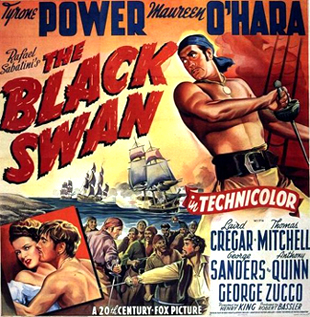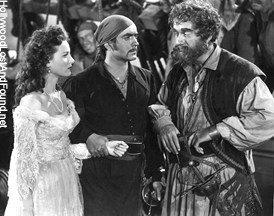 |
|||||||
|
|
|||||||
|
"The Black Swan" (1942) |
|||||||
| The basic approach to movie swashbucklers was set by Douglas Fairbanks, Sr. in his series of silent big budget action films of the Twenties: respectful, reasonably historically accurate, but with an overall sense of fun. Warner Bros stuck with this approach in the series of Thirties films it did with Errol Flynn, as did most of the other studios attempting swashbucklers over the next two decades. 20th Century-Fox chose to deviate from this approach with three of its swashbucklers: "The Mark of Zorro" (1940), "The Black Swan" (1942), and "Prince Valiant" (1954), taking a far more tongue-in-cheek approach without descending into parody of the "Princess And The Pirate" (1944) or "Abbott and Costello Meet Captain Kidd" (1952) variety. |
|||||||
 |
|||||||
"The Black Swan" is the least known of these films, but actually one of the best pirate films ever made. Supposedly based on a novel by Rafael Sabatini (apparently all the "adaptations" from Sabatini only appended his titles to essentially original works), the film deals with pirate Henry Morgan (Laird Cregar) pardoned, knighted and made governor of Jamaica with the mandate to rid the West Indies of pirates by either persuading the captains to take their ships into legitimate trade or wiping them out. One of Morgan's former cohorts, Jamie Waring (Tyrone Power), joins him but another, Billy Leech (George Sanders), continues his piratical ways with Waring ordered to capture him. This is complicated by Waring having fallen for the daughter of the former governor (Maureen O'Hara), whose fiancé, while leading the political opposition to Morgan, is also supplying Leech with information about lootable ships for a share of the booty. Naturally there are a lot of clanging cutlasses and a climactic attack on Port Royale before all is wrapped up in a fast 85 minutes. None of this is played seriously, especially by Power, Cregar, Thomas Mitchell, and particularly Sanders, and even the Technicolor gorgeous 22 year old Maureen O'Hara seems to be in on the joke. Henry King, the quintessential studio A director, was not noted for bringing a humorous touch to his films, yet the consistency of the film's tone can't be attributed totally to the script by Ben Hecht and Seton I. Miller (the latter worked on some of the Warner Flynn films); everyone seems to be having a great time doing essentially "The Dead End Kids play pirate." |
|||||||
 |
|||||||
"The Black Swan" was the first pirate film to be photographed in three strip Technicolor (the AFI Catalog synopsis suggests that "The Dancing Pirate" (RKO; 1936) actually had little to do with pirates), beautifully so in the hands of the legendary Leon Shamroy, ASC. In addition to showing off Miss O'Hara at her most beauteous, many shots in the film evoke classic 17th Century paintings, and include some of the most beautiful sunsets ever photographed on a soundstage. (For the record, Fairbanks' "The Black Pirate" (United Artists; 1926) was photographed in two color Technicolor.) This is all appropriately wrapped up in one of Alfred Newman's great scores, including a typically beautiful love theme. Newman would reuse his "New World" theme from this film in his classic score for "Captain From Castile" (1947). It would be interesting to see how "The Black Swan" fares against "Pirates Of The Caribbean" with contemporary audiences; these days it's hard to predict which one would come out on top. |
|||||||
|
- Rick Mitchell
5 August 2006 |
|||||||
 |
|||||||
|
Back to Recommendations |
|||||||
|
Home / Features / Film Sound / Movie Props / Locations Trivia / Events / Tributes / Recommendations / Blog / About Bibliography / Links / FAQs / Shop / Message Board / Disclaimers / Site Map |
|||||||
Please support our site by visiting our affiliates: